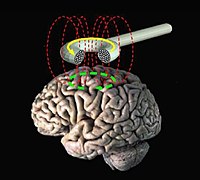
Photo from wikipedia
Abstract Objective To evaluate the efficacy of high-frequency repetitive transcranial magnetic stimulation over dorsolateral prefrontal cortex as a migraine prevention by conducting a systematic review and meta-analysis. Background The efficacy… Click to show full abstract
Abstract Objective To evaluate the efficacy of high-frequency repetitive transcranial magnetic stimulation over dorsolateral prefrontal cortex as a migraine prevention by conducting a systematic review and meta-analysis. Background The efficacy of high-frequency repetitive transcranial magnetic stimulation over dorsolateral prefrontal cortex as preventive migraine treatment remains debatable. Methods PubMed, Scopus, CINAHL, CENTRAL, and BioMed Central databases were searched from their inception until December 2020. Randomised trials comparing high-frequency repetitive transcranial magnetic stimulation over dorsolateral prefrontal cortex with sham for migraine prevention were included. The risk of bias was assessed using the Cochrane guidelines. Headache days, pain intensity, acute medication intake, and disability were extracted as study outcomes and the mean difference with a random-effects model was used to determine the effect size. Results Meta-analysis revealed that high-frequency repetitive transcranial magnetic stimulation over dorsolateral prefrontal cortex significantly reduced acute medication intake (Mean Difference = 9.78, p = 0.02, 95%CI: 1.60, 17.96, p = 0.02) and functional disability (Mean Difference = 8.00, p < 0.05, 95%CI: 4.21, 11.79). However, no differences were found in headache days and pain intensity reduction, although there was a slight trend favouring high-frequency repetitive transcranial magnetic stimulation. Conclusion High-frequency repetitive transcranial magnetic stimulation over dorsolateral prefrontal cortex may be effective in reducing acute medication intake and disability. However, more studies are needed to strengthen this preliminary evidence.
Journal Title: Cephalalgia
Year Published: 2022
Link to full text (if available)
Share on Social Media: Sign Up to like & get
recommendations!